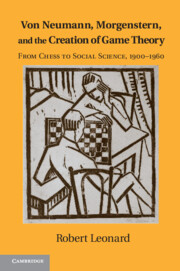Book contents
- Frontmatter
- Contents
- Acknowledgments
- Von Neumann, Morgenstern, and the Creation of Game Theory
- Introduction
- Part One Struggle and Equilibrium: from Lasker to von Neumann
- Part Two Oskar Morgenstern and Interwar Vienna
- Part Three From War to Cold War
- 9 Mathematics and the Social Order
- 10 Ars Combinatoria
- 11 Morgenstern's Catharsis
- 12 Von Neumann's War
- 13 Social Science and the “Present Danger”
- Conclusion
- Bibliography
- Index
- Plate section
13 - Social Science and the “Present Danger”
Game Theory and Psychology at the RAND Corporation, 1946–1960
Published online by Cambridge University Press: 05 December 2013
- Frontmatter
- Contents
- Acknowledgments
- Von Neumann, Morgenstern, and the Creation of Game Theory
- Introduction
- Part One Struggle and Equilibrium: from Lasker to von Neumann
- Part Two Oskar Morgenstern and Interwar Vienna
- Part Three From War to Cold War
- 9 Mathematics and the Social Order
- 10 Ars Combinatoria
- 11 Morgenstern's Catharsis
- 12 Von Neumann's War
- 13 Social Science and the “Present Danger”
- Conclusion
- Bibliography
- Index
- Plate section
Summary
[I]t was a long time that I was in what was called the “contamination ward”. We tried to work on some problems and things like that, but it was mostly a matter of waiting until we did get a clearance…You know, you couldn't move around and you couldn't go to other parts of the building where these people were located, except for a short period of time into your administrative offices or things like that. Because you had problems with a lot of the walls…they do not go to the ceiling and things that are going on in one office can be heard in another.
Robert Belzer (RAND game theorist), NASM interview, p. 9In general, the procedure should be to discover breaking points under pressure, similar to the physical techniques of determining such for material and shapes. All this could be tied up closely with the problems of target analysis, the construction of a national redoubt, etc.
Oskar Morgenstern (1954b), “The Compressibility of Organisations and Economic Systems”, RAND RM-1325, Aug. 17, p. 19Introduction
It was summer 1948, at the intersection of 4th St. and Broadway in Santa Monica, California. The building was formerly the office of the Evening Outlook newspaper, and one would have had to look closely to notice the new doors and locks, and the security guard. Inside, more than forty people had gathered for a seminar, one of many in the building that summer. All eyes were on von Neumann, his dark suit appearing even more conspicuous in informal California. The discussion was about the duels between two fighter aircraft, and, describing a game with a continuum of strategies and a discontinuous payoff function, somebody had asked von Neumann if he could prove that it had no solution. After his habitual minute staring into the mid-distance, von Neumann turned to the board, talking and writing quickly, the eraser, as always, never very far behind.
- Type
- Chapter
- Information
- Von Neumann, Morgenstern, and the Creation of Game TheoryFrom Chess to Social Science, 1900–1960, pp. 293 - 343Publisher: Cambridge University PressPrint publication year: 2010

